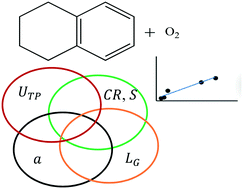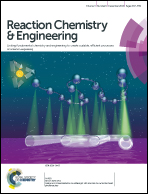A statistical approach dealing with multicollinearity among predictors in microfluidic reactor operation to control liquid-phase oxidation selectivity†
Abstract
Oxygen availability was identified to play a key role in determining the product selectivity of tetralin oxidation conducted at a constant temperature and pressure in a microfluidic reactor. The current study is concerned with applying chemometrics involving regression techniques to identify a single most important parameter that directly affects oxygen availability and has a high influence on tetralin conversion (CR) and product selectivity (S). Five parameters (predictors) identified previously were the gas–liquid interfacial area (a), the length of the oxygen gas bubble (LG), the length of the liquid slug (LS), the two-phase superficial velocity (UTP) and the liquid flow rate to the reactor (Q), where ‘a’ was suspected to be directly related to oxygen availability. CR and S were regressed on all the predictors by fitting separate simple linear regression (SLR) models. The decreasing order of explained variance in the outputs based on the calibration model was as follows: in CR: a2 > LG > U3TP > LS > Q; in S: a > LG > U2TP > Q. The powers of the variables indicate the respective best fits determined through evaluation of statistical performance measures. Multicollinearity issues among predictors were detected through Pearson's correlation coefficients and diagnostics like variance inflation factors (VIF) and eigenvalues of the correlation matrix. This issue was addressed through multiple linear regression (MLR) by considering a second input in addition to the best predictor from the SLR (a). Drastic changes in regression coefficient estimates and inflated standard errors rendered the coefficients of all other variables (except ‘a’) insignificant in the MLR models. The incremental contribution of ‘a’ towards improving the output variance was also confirmed through F-tests and partial correlations with the outputs, controlling for other variables as well. Thus, it could be stated with certainty that the gas–liquid interfacial area affected the outcomes the most. The findings from this study could be applied in industrial reactor design (for example – loop reactors), where the product selectivity can be controlled effectively through a higher interfacial area. In addition, through chemometrics, the reaction progress could be monitored by predicting reactant conversion and product selectivity, thereby eliminating the need for offline gas chromatographic (GC) measurements.



 Please wait while we load your content...
Please wait while we load your content...